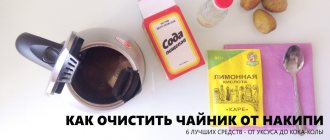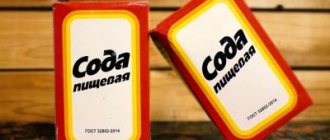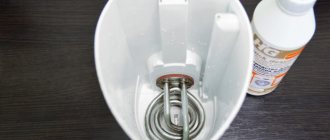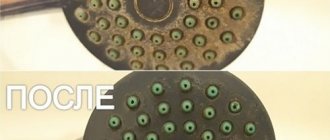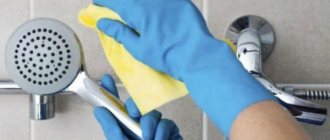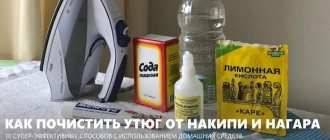Even the use of the most modern water filters does not completely purify water from calcium and magnesium salts. It is these minerals that form the limestone layer that settles on the inner surface of the kettle.
As plaque accumulates, the device begins to heat the liquid worse, and the quality of drinking water decreases significantly.
Find out how to quickly and effectively clean an electric kettle using improvised means and household chemicals.
Why is scale dangerous?
The appearance of deposits is associated with the use of hard water. Often even filtered water produces a small amount of scale.
The “overgrown” inner walls of the kettle present a pitiful sight. Solid layers of carbonates (crystallized calcium and magnesium salts) settle inside the flask, on heating elements, and form a precipitate in the water in the form of whitish flakes.
Plaque covers the walls, spirals or disc, slowing down the heating of the liquid, increasing the boiling time, and, consequently, energy consumption.
Tea brewed in such water has foreign impurities, odors, and is tasteless. There are no scientifically proven facts about the dangers of hard water for the human body, but drinking a tasteless drink (due to a dirty kettle) is not very pleasant.
Lime deposits covering the walls and heating elements impair the heat transfer of the device. The kettle works at the limit, makes a lot of noise when it boils, and breaks down faster. Do not underestimate the harm of scale; it is better to clean the device regularly and not let it become a karst cave.
Do water filters save you?
I used a similar water filter.
At first I tried to outwit nature, I’m the smartest, and use a water filter, you know, a jug like that (if I’m not mistaken, the name of this miracle of engineering is “Barrier”). You pour water into it into the upper container, and it slowly flows through the filter and at the bottom is already clean, clean (well, that’s what they told me at the store). My disappointment knew no bounds, maybe there was a tiny effect, but, to be honest, I didn’t notice it.
Cleaning an electric kettle: what to pay attention to
At home, household chemicals are suitable for cleaning the inside of the device; they are available in large quantities on the shelves of hardware stores. Compositions based on folk recipes that have been tested in practice and do not require large financial expenses give good results.
Before you remove scale from an electric kettle, you need to understand its structure and take into account its design features. The body and flask of devices, if any, are made of different materials (glass, stainless steel, plastic, ceramics), so not every composition is suitable for cleaning.
Do not use steel wool, knives, or hard brushes, as you can easily damage the surface of the reservoir, spirals, and disk, and you will have to replace the device. Electronically controlled models are especially carefully cleaned.
When removing scale, mechanical methods are excluded, and abrasive powders are not used.
Not recommended for use
How to effectively clean an electric kettle from old scale at home? Use gentle products. The following should not be used to clean electric kettles:
- peels of fruits and vegetables. The method is effective only for enamel and metal cookware without electric heating;
- drinks with dyes. There is a risk that colored particles will remain on the inner surface of the kettle;
- triple impact method - citric acid, soda and vinegar. An aggressive mixture can damage the surface of the device;
- brine and marinade. This method is also only suitable for cookware that is heated on the stove.
Important! The choice of cleaning method depends on the material from which the kettle is made.
Effective cleaning products
The simplest and easiest way to remove recent deposits is small lime deposits that have not had time to “harden”. You will have to tinker with old scale, so if you use hard water for boiling, wash the kettle from the inside at least once a week.
Available means are used:
- soda;
- table vinegar (6-9%);
- citric acid powder;
- apple peel;
- peeling potatoes;
- carbonated drinks.
After cleaning with any composition, the kettle must be washed, boiled 2-3 times, draining the liquid, and only then water for tea is collected.
How to get rid of rust?
In difficult cases, when you have to deal not only with lime, but also need to wash off rust, a three-stage cleaning will help:
- The first time the device is boiled with baking soda in a ratio of 1 large spoon per liter of water.
- The second time, boiling is carried out with citric acid in the same proportions.
- The procedure is completed by boiling with table vinegar - 100 ml per liter of liquid.
Each time, the boiled liquid is left to stand for 15-20 minutes, drained and the device is washed.
If rust has formed on the outer surface of the appliance, you can use washing powder. It is poured onto the soft side of a kitchen sponge, rubbed against the rust and left for half an hour to react.
Were the tips in the article helpful to you?
Not really
Stainless steel
Practical and durable steel kettles are cleaned using chemical compounds. Traditional recipes include options with soda, vinegar, fruit and vegetable peelings, and soda.
Light deposits can be cleaned with a brush, but it is better not to risk it and use liquid compounds. A solution with soda and laundry soap shavings removes dirt well. After boiling, the mixture is drained and the walls are rubbed until shiny with a sponge.
Glass teapots
Devices with transparent walls require special attention and regular cleaning. Any dirt is visible in such kettles, and if you forget about maintenance, the beautiful device will quickly become overgrown with scale.
The most popular options: soda, citric acid (or natural citrus), salt, laundry soap. Vinegar and brine are used for old stains - just like soda. Household chemicals - only according to the instructions, if glass is specified in the area of application.
Features of cleaning heating elements
Removing scale from an electric kettle requires care. The fact is that the devices are equipped with different types of heating elements.
It can be:
- spirals (open, closed);
- disk.
In each case, different cleaning methods are used, otherwise the heater can be easily damaged.
Open spiral
A tubular electric heater (TEH) is located in the lower part of the device body; its design resembles a familiar boiler. It is made from stainless steel, as well as from steel with a nickel or chrome plated finish.
The heating element comes into contact with water, so hardness salts quickly settle on it. Plaque reduces heat transfer, the device works hard, consuming a lot of energy when boiling.
In expensive models, spirals can be made of titanium alloy, brass, and even gold-plated. Scale does not accumulate on such heating elements, since the materials are characterized by a self-cleaning function.
To remove limescale in electric kettles with an open heating element, use soda solution, citric acid, or a carbonated drink. Small deposits can be removed by boiling salt and soap. It is advisable not to use vinegar and brine, as they corrode not only the carbonate layers, but also the surface of the spiral. In order for the kettle to serve for a long time, it is recommended to clean the container more often and use filtered water for boiling.
Addition – clean external carbon deposits and grease
Enamel, stainless steel and aluminum are covered with soot and soot on the outside. This spoils the appearance. First, try cleaning with detergent and a sponge. But if all else fails, they begin to use hard artillery.
Option 1. Boiling in soda solution
First, collect water in a large metal container (so that the item being cleaned will fit). Make a solution at the rate of 1 tbsp. l. for 1l. Lower the stainless steel bowl and leave it in the bubbling water for 30 minutes, then cool. Then clean the surface under running water with a hard sponge.
Option 2. Cleaning with soda slurry
For the operation you need to heat the kettle. Don't overdo it - you should feel comfortable holding it in your hands. While the kettle is heating, make a soda slurry with water: 3 parts soda to 1 part water.
Apply the paste to the surface, do not touch for 5 minutes. and now rub with the hard side of the napkin.
Option 3. For aluminum and stainless alloy items
To clean, you will need to make a solution: 3 tbsp. l. (vinegar 9%) and 1l. (water). The container is boiled for 20 minutes, cooled and washed.
Closed spiral
The heating element is of exactly the same design as the closed type, but it is “hidden” under the metal bottom of the kettle. There is no direct contact with water, so the spiral does not become coated. All scale and dirt remains on the walls and bottom of the device, and this also slows down the heating and boiling process.
Any of the above cleaning methods are suitable for such models. The main thing is to consider what material the device body is made of and follow the recommendations for dosage and proportions.
Disc heater
The plate to which the electrical contacts are connected is considered more hygienic, easy to clean (easy to clean from scale and dirt), and faster in terms of boiling speed. The cost of devices with disk heaters is higher than devices with open heating elements, but the price is justified.
Typically, such models operate on a stand (base) with the ability to rotate 360 degrees. It's convenient and practical. For comparison: models with an open spiral can often be placed on the base only in a strictly defined position.
Any methods listed in the section above are suitable for removing lime deposits. Cleaning solutions do not come into contact with the contacts and do not cause damage to the heater.
Washing electric kettles of any type in the dishwasher is prohibited!
Preventing scale formation
In order not to find the most economical and effective means and methods for ridding your favorite kettle of corrosive scale, do not forget about prevention.
Helpful Tips:
- try to draw water only before boiling, and then drain the remainder;
- To soften hard water, it is recommended to install special filters in the kitchen;
- If there is no cleaning system, then you need to pour water into containers in advance and let it settle. Another option is to buy a bottled product, but only from trusted suppliers;
- Every time after drinking tea, you should wash the kettle and rinse thoroughly;
- Do not boil water several times;
- Clean the container regularly using baking soda or mild detergents.
Housewives usually know well the characteristics of the water used in their apartment or house. At high hardness levels, it is necessary to install filtration systems, otherwise a constant fight against scale will be ensured not only in the kettle, but also in all kitchen utensils.
Consider the options and possibilities of ordering water, at least for drinking and cooking, and do not forget about regular washing and removing deposits. Rinse the kettle every day and then you won’t have to deal with old scale.
Cleaning limescale from an electric kettle depending on the material
Metal
To prevent subsequent malfunctions, timely cleaning is necessary. Before descaling the kettle, you need to turn it off from the electricity and cool it (leave it for a couple of hours to cool on its own).
Then you need to choose a cleaning option: chemical or mechanical. In mechanical cases, scale is carefully removed using wooden, plastic, or silicone brushes. It is important to remove all layers so that in the future the water is heated evenly and overheating is avoided.
Interesting! Files and sandpaper are rough on metal and cause scratches, so they are not used.
To use the chemical method, you need products with high acidity. Treatment can be periodic (once every 1-2 months) or radical (in advanced cases). Don't forget to pay attention to the mesh near the spout - it is cleaned daily.
After completing the procedures, you need to boil it twice and rinse with water.
Plastic
Vinegar of any concentration and soda are harmful to plastic. Lemon is suitable - it is considered the most universal for various surfaces.
It happens that there is not a large layer of lime on surfaces, then you can pour a liter of water, add lemon, stir and leave for 3-4 hours. If after soaking the stain does not go away, then boil it and follow the instructions as in the previous paragraph.

